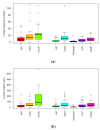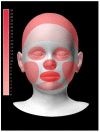Hand-to-Face Contact of Preschoolers during Indoor Activities in Childcare Facilities in the Republic of Korea
- PMID: 36293861
- PMCID: PMC9603519
- DOI: 10.3390/ijerph192013282
Hand-to-Face Contact of Preschoolers during Indoor Activities in Childcare Facilities in the Republic of Korea
Abstract
Purpose: This study aimed to characterize hand-to-face contact (HFC) in children and analyze the factors that affect HFC behaviors of preschoolers in childcare facilities in Korea.
Methods: Thirty preschoolers aged between 13 and 84 months were enrolled with parents' voluntary participation. Videotaping (10 children/childcare center/2 h) and video reading was performed from 23 November 2018 to 7 January 2019.
Results: A total of 2719 cases of HFC were observed in 30 participants within 2 h. The average contact with the facial mucosa (frequency/person/2 h) was 55.6 ± 42.2, of which the mouth (25.4 ± 23.9), the nose (20.4 ± 24.5), and the eye (9.8 ± 11.7) were the most frequent contacts, in that order. The average contact duration (sec/person/2 h) with the facial mucosa was 232.6 ± 169.7, of which the mouth (145.2 ± 150), the nose (57.6 ± 62.2), and the eyes (29.7 ± 42.3) were the longest in that order. The density distribution of the frequency and duration of mucosal contact was wider in boys than in girls. The mucosal and non-mucosal contact frequencies were significantly higher in boys (p = 0.027 and p = 0.030, respectively).
Conclusion: Children's HFC frequency and duration were highest for the mouth, nose, and eyes. Boys tended to have a higher contact frequency than girls for both mucous and non-mucous HFC.
Keywords: contact behavior; hand hygiene; preschool children; self-inoculation.
Conflict of interest statement
The authors declare no conflict of interest.
Figures




Similar articles
-
Hand-to-face contact behaviors during indoor activities in daily life among Korean adults: an observational pilot study using videotaping.Epidemiol Health. 2021;43:e2021030. doi: 10.4178/epih.e2021030. Epub 2021 Apr 22. Epidemiol Health. 2021. PMID: 33887819 Free PMC article.
-
An observational study of hand-to-face contact via videotaping of Korean older people in daily life settings.Int J Older People Nurs. 2022 Jan;17(1):e12414. doi: 10.1111/opn.12414. Epub 2021 Aug 22. Int J Older People Nurs. 2022. PMID: 34420266
-
Frequency of hand-to-head, -mouth, -eyes, and -nose contacts for adults and children during eating and non-eating macro-activities.J Expo Sci Environ Epidemiol. 2021 Feb;31(1):34-44. doi: 10.1038/s41370-020-0249-8. Epub 2020 Jul 15. J Expo Sci Environ Epidemiol. 2021. PMID: 32669669 Free PMC article.
-
Physical activity and sedentary behavior legislation in Canadian childcare facilities: an update.BMC Public Health. 2018 Apr 11;18(1):475. doi: 10.1186/s12889-018-5292-1. BMC Public Health. 2018. PMID: 29642891 Free PMC article. Review.
-
Physical activity and sedentary time among preschoolers in centre-based childcare: a systematic review.Int J Behav Nutr Phys Act. 2018 Nov 21;15(1):117. doi: 10.1186/s12966-018-0745-6. Int J Behav Nutr Phys Act. 2018. PMID: 30463585 Free PMC article.
Cited by
-
Understanding the risk of transmission of respiratory viral infections in childcare centres: protocol for the DISeases TrANsmission in ChildcarE (DISTANCE) multicentre cohort study.BMJ Open Respir Res. 2023 Apr;10(1):e001617. doi: 10.1136/bmjresp-2023-001617. BMJ Open Respir Res. 2023. PMID: 37028911 Free PMC article.
References
-
- WHO . Guidelines on Hand Hygiene in Health Care: First Global Patient Safety Challenge Clean Care Is Safer Care. WHO; Geneva, Switzerland: 2009. - PubMed
Publication types
MeSH terms
Grants and funding
LinkOut - more resources
Full Text Sources

